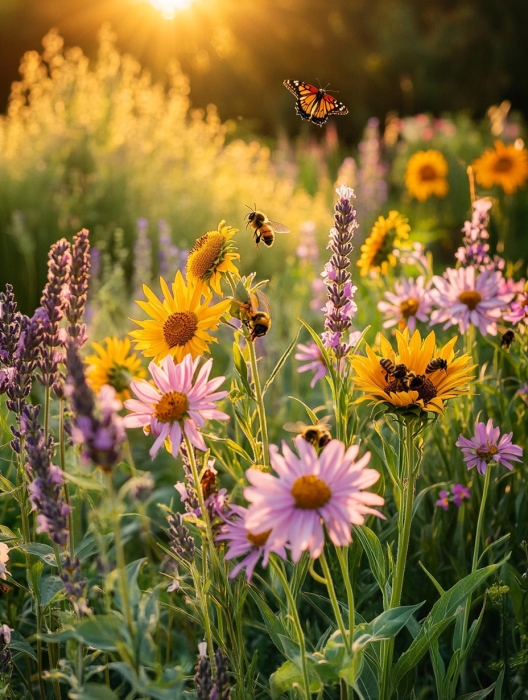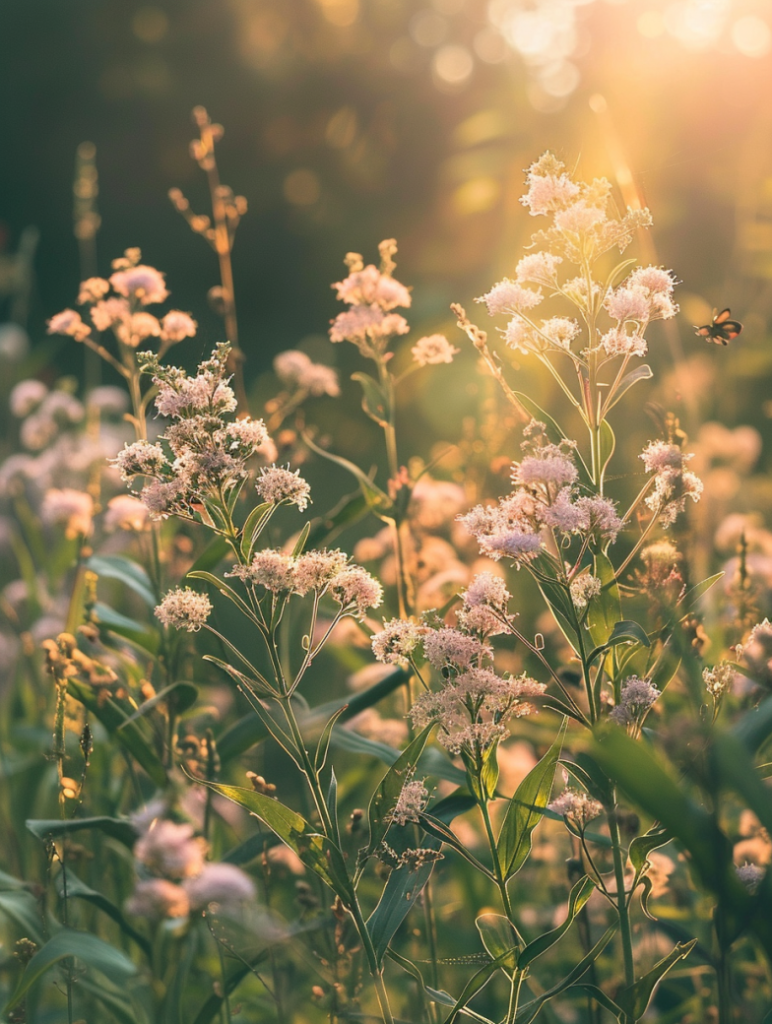
Creating a pollinator-friendly garden requires more than just planting flowers—you need the right varieties that provide ample nectar, pollen, and habitat for bees, butterflies, and other beneficial insects. Below is an in-depth guide to the 21 best plants for attracting pollinators, including their growing conditions, bloom times, and unique benefits.
1. Lavender (Lavandula)

- Bloom Time: Late spring to summer
- Colors: Purple, blue, pink, white
- Sunlight: Full sun (6+ hours/day)
- Soil: Well-drained, slightly alkaline
- Why Pollinators Love It: High nectar content, strong fragrance
- Bonus: Drought-resistant, deer-resistant, great for borders and containers
2. Sunflower (Helianthus annuus)

- Bloom Time: Summer to early fall
- Colors: Yellow, red, orange, bi-colored
- Sunlight: Full sun
- Soil: Fertile, well-drained
- Why Pollinators Love It: Large, pollen-rich centers
- Bonus: Seeds attract birds; dwarf varieties work in small gardens
3. Coneflower (Echinacea purpurea)

- Bloom Time: Summer to fall
- Colors: Purple, pink, white, orange
- Sunlight: Full sun to partial shade
- Soil: Well-drained, tolerates drought
- Why Pollinators Love It: Long-lasting blooms, high nectar production
- Bonus: Medicinal properties; great for cut flowers
4. Bee Balm (Monarda didyma)

- Bloom Time: Mid to late summer
- Colors: Red, pink, purple, white
- Sunlight: Full sun to partial shade
- Soil: Moist, rich
- Why Pollinators Love It: Tubular flowers perfect for hummingbirds and bees
- Bonus: Leaves can be used for herbal tea
5. Butterfly Bush (Buddleia davidii)

- Bloom Time: Summer to fall
- Colors: Purple, pink, white, yellow
- Sunlight: Full sun
- Soil: Well-drained
- Why Pollinators Love It: Fragrant, cone-shaped flower clusters
- Bonus: Fast-growing; attracts swallowtails and monarchs
6. Zinnia (Zinnia elegans)

- Bloom Time: Summer until frost
- Colors: Red, orange, pink, yellow, white
- Sunlight: Full sun
- Soil: Well-drained, average fertility
- Why Pollinators Love It: Continuous blooming, easy-to-access nectar
- Bonus: Great for cut flowers; resistant to deer
7. Milkweed (Asclepias)

- Bloom Time: Summer
- Colors: Pink, orange, white, purple
- Sunlight: Full sun
- Soil: Well-drained, tolerates poor soil
- Why Pollinators Love It: Essential for monarch butterflies (host plant)
- Bonus: Drought-tolerant; seed pods attract birds
8. Salvia (Salvia spp.)

- Bloom Time: Spring to fall (varies by species)
- Colors: Blue, purple, red, white
- Sunlight: Full sun
- Soil: Well-drained
- Why Pollinators Love It: Tubular flowers hold abundant nectar
- Bonus: Deer-resistant; some varieties are perennial
9. Black-Eyed Susan (Rudbeckia hirta)

- Bloom Time: Summer to early fall
- Colors: Yellow, gold, orange
- Sunlight: Full sun
- Soil: Adaptable, drought-tolerant
- Why Pollinators Love It: Daisy-like blooms with easy-to-access pollen
- Bonus: Self-seeding; great for wildflower gardens
10. Catmint (Nepeta)

- Bloom Time: Late spring to fall
- Colors: Lavender-blue, white
- Sunlight: Full sun to partial shade
- Soil: Well-drained
- Why Pollinators Love It: Long blooming period, fragrant foliage
- Bonus: Deer-resistant; low-maintenance
11. Aster (Symphyotrichum)

- Bloom Time: Late summer to fall
- Colors: Purple, blue, pink, white
- Sunlight: Full sun to partial shade
- Soil: Well-drained, moist
- Why Pollinators Love It: Critical late-season nectar source
- Bonus: Supports migrating monarchs
13. Phlox (Phlox paniculata)

- Bloom Time: Summer
- Colors: Pink, purple, white, red
- Sunlight: Full sun to partial shade
- Soil: Moist, well-drained
- Why Pollinators Love It: Sweet fragrance, clustered blooms
- Bonus: Attracts hummingbirds
14. Yarrow (Achillea millefolium)

- Bloom Time: Early to late summer
- Colors: White, yellow, pink, red
- Sunlight: Full sun
- Soil: Well-drained, drought-tolerant
- Why Pollinators Love It: Flat flower clusters for easy feeding
- Bonus: Medicinal uses; deer-resistant
15. Cosmos (Cosmos bipinnatus)

- Bloom Time: Summer to frost
- Colors: Pink, white, orange, yellow
- Sunlight: Full sun
- Soil: Tolerates poor soil
- Why Pollinators Love It: Open, daisy-like blooms
- Bonus: Self-seeding; great for beginner gardeners
16. Lantana (Lantana camara)

- Bloom Time: Summer to frost
- Colors: Multi-colored (pink, yellow, orange, red)
- Sunlight: Full sun
- Soil: Well-drained
- Why Pollinators Love It: Continuous nectar source
- Bonus: Heat and drought-tolerant
17. Joe-Pye Weed (Eutrochium purpureum)

- Bloom Time: Late summer to fall
- Colors: Pinkish-purple
- Sunlight: Full sun to partial shade
- Soil: Moist, rich
- Why Pollinators Love It: Massive flower heads attract swarms of butterflies
- Bonus: Great for rain gardens
18. Marigold (Tagetes)

- Bloom Time: Summer to frost
- Colors: Yellow, orange, red
- Sunlight: Full sun
- Soil: Well-drained
- Why Pollinators Love It: Nectar-rich, pest-repellent
- Bonus: Deters garden pests like nematodes
19. Verbena (Verbena bonariensis)

- Bloom Time: Summer to fall
- Colors: Purple, pink, white
- Sunlight: Full sun
- Soil: Well-drained
- Why Pollinators Love It: Tiny clustered flowers for easy feeding
- Bonus: Airy growth habit fits in tight spaces
20. Sedum (Stonecrop)

- Bloom Time: Late summer to fall
- Colors: Pink, red, white
- Sunlight: Full sun
- Soil: Well-drained, drought-tolerant
- Why Pollinators Love It: Late-season blooms when other flowers fade
- Bonus: Succulent leaves store water
21. Anise Hyssop (Agastache foeniculum)

- Bloom Time: Summer to fall
- Colors: Purple, blue
- Sunlight: Full sun
- Soil: Well-drained
- Why Pollinators Love It: Licorice-scented flowers attract bees and butterflies
- Bonus: Leaves can be used in tea
Final Tips for a Buzzing Garden
✔ Plant in groups – Clusters of the same flower help pollinators find food efficiently.
✔ Include host plants – Milkweed for monarchs, parsley for swallowtails.
✔ Avoid pesticides – Opt for natural pest control like ladybugs and neem oil.
✔ Provide water – A shallow dish with pebbles makes a safe drinking spot.
By choosing these 21 pollinator-friendly plants, you’ll create a vibrant, eco-friendly garden buzzing with life!
Which flowers are you excited to plant? 🌸🐝🦋